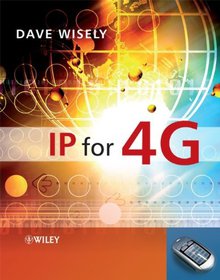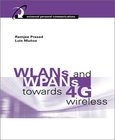IP for 4G

Book Details:
| Publisher: | Wiley |
| Series: | Wiley |
| Author: | David Wisely |
| Edition: | 1 |
| ISBN-10: | 0470510161 |
| ISBN-13: | 9780470510162 |
| Pages: | 314 |
| Published: | Feb 24 2009 |
| Posted: | Nov 19 2014 |
| Language: | English |
| Book format: | |
| Book size: | 37.85 MB |
Book Description:
Excellent reference with expert insight into the future evolution of mobile communications: 4GIP for 4G examines the concept of 4G, providing an in-depth background to the key technologies and developments shaping the new generation of mobile services, including Wireless Local Area Networks (WLANs), Worldwide Interoperability for Microwave Access (WiMAX), IP developments (SIP and Media Independent Handover), Internet Multimedia Subsystem (IMS), and 3G (HSDPA and LTE). The book addresses these key technological drivers in light of commercial propositions such as generating extra revenue and reducing costs, and offers an up-to-date briefing on the future of mobile communications in the coming years.Key features:Presents and analyses the key technological drivers of 4G, including WLANs, WiMAX, convergence and IMSExamines the rationale for IP for 4G by bringing together technologies, global developments and economic arguments in one single volumeDescribes and puts in context the developments in the IEEE 802.21 Media Independent Handover group, in particular the options for network/terminal controlled handover and the likely mechanisms for seamless handover including application adaptationWritten for readability as well as depth with access to detailed descriptions of technologies but also quick overviewsContains scenario descriptions to motivate the need for seamless handover and benefits for the user (single sign-on access to networks, single billing)Contains hundreds of original diagrams carefully drawn to illustrate the complex technology and quickly provide a summary of the main issues.Accompanying website supports the book with additional diagrams, figures and references for further readingIP for 4G is an invaluable reference for professionals in mobile/fixed telecoms and ICT industries, practicing telecommunications and network engineers, system designers and developers. Graduate level students studying MSc and higher-level courses on networking will also find this book of interest.
Download Link:
Related Books:
Error Control Coding
For B3G/4G Wireless Systems
Covering the fast evolving area of advanced coding, Error Control Coding for B3G/4G Wireless Systems targets IMT-Advanced systems to present the latest findings and implementation solutions. The book begins by detailing the fundamentals of advanced coding techniques such as Coding, Decoding, Design, and Optimization. It provides not only state-of-the-art research findings in 3D Turbo-codes, non-binary LDPC Codes, Fountain, and Raptor codes, but also insights into their real-world implementation by examining hardware architecture solutions, for example VLSI complexity, FPGA, and ASIC. Furthermore, special attention is paid to Incremental redundancy techniques, which constitute a key feature of Wireless Systems.A promising application of these advanced...
Turbo Decoder Architecture for Beyond-4G Applications
This book describes the most recent techniques for turbo decoder implementation, especially for 4G and beyond 4G applications.The authors reveal techniques for the design of high-throughput decoders for future telecommunication systems, enabling designers to reduce hardware cost and shorten processing time.Coverage includes an explanation of VLSI implementation of the turbo decoder, from basic functional units to advanced parallel architecture. The authors discuss both hardware architecture techniques and experimental results, showing the variations in area/throughput/performance with respect to several techniques. This book also illustrates turbo decoders for 3GPP-LTE/LTE-A and IEEE 802.16e/m standards, which provide a low-complexity but high-flexib...
WLANs and WPANs towards 4G Wireless
An exploration of the present and future trends of WLANs and WPANs. It examines the path that these infrastructures are following from a perspective of synergies with 3G systems, and how they will pave the way for future 4G systems. The authors present an overview of 3G networks and standards, and discuss intraworking and handover mechanisms between WLANs and WPANs when they support the TCP/IP stack. Several critical issues are explored in depth, including IP routing and mobility, the ad hoc concept, IEEE 802.11 and the HIPERLAN/2 standards, PHY and MAC layers for the main WLAN specifications, the TCP-UDP/IP protocol stack, and 802.11b over TCP/IP....
2007 - 2021 © eBooks-IT.org



